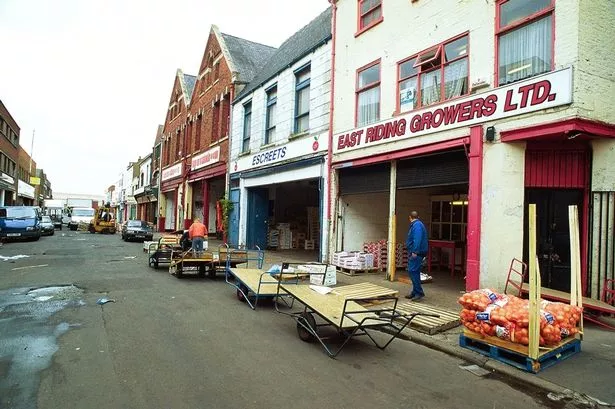Background to Humber Street, Hull
Hull is a city in the East Riding of Yorkshire with a population of 267,020. It is a port city located on the River Humber.
Humber Street was once the heart of Hull’s Fruit Market. It was home to the city’s fruit trade, where traders would store, buy and sell fruit until as recently as 2009.
The image below shows Humber Street when it was used for trading fruit.
Below is the same location in September 2023.
The Hull Fruit Market redevelopment project is a key priority within Hull’s Big City Plan. It aims to create and sustain city jobs and boost the tourist economy by drawing visitors to Hull’s transforming waterfront. Humber Street was first on the Hull Fruit Market redevelopment agenda. The redevelopment of Humber Street was completed in 2016 and included refurbishing existing buildings, rebuilding those that were unsafe and pedestrianising the street.
Virtual Fieldwork
The 360 image below shows Humber Street at 12.35 pm on Monday, 25th September 2023.
The 360 video below shows Humber Street at 12.35 pm on Monday, 25th September 2023.
Environmental Quality Surveys
An environmental quality survey is like a report card for the environment. People look around and score the environment based on certain things they notice, like how clean the air is or how many trees there are. They might give scores like 1 to 5, where one means it’s not good and five means it’s really good. However, since different people might see things differently, these scores can be based on personal opinions (they are subjective). Some will find a location unattractive, while others may find the exact place very attractive. To make it more fair, comparing scores between different people can help ensure they’re not too biased.
What are the advantages of environmental quality surveys?
- Easy to Conduct: These surveys are relatively simple and can be carried out by students or community members without extensive technical equipment.
- Provides Direct Observation: Directly observing an environment can offer insights that might not be apparent in quantitative data.
- Adaptable: The survey criteria can be tailored to fit specific environments or to emphasise certain features.
- Cost-Effective: Environmental quality surveys can be less expensive than other data collection methods.
- Immediate Results: Observers can quickly collate and analyse the collected data.
- Direct comparisons: As the rating system remains the same, it is useful for comparing areas.
What are the disadvantages of environmental quality surveys?
- Subjectivity: As these surveys often rely on personal judgement, they can be subjective. Different observers might rate the same environment differently.
- Lack of Standardisation: Surveys can vary in quality and focus without standard guidelines, making comparisons difficult.
- Time-Bound: Conditions might change due to the time of day, season, or weather, which can influence survey results.
- Limited Coverage: Surveys might only cover a small area, missing broader environmental issues.
- Potential Biases: Observers might have personal biases that influence their scores, whether they’re conscious of them or not.
- Not Always Comprehensive: The survey might overlook certain environmental factors if they aren’t part of the survey criteria.
How can the data from environmental quality surveys be presented?
Bar charts and radial diagrams effectively present the findings of an environmental quality survey. As the data is discrete, line graphs and histograms should not be used (as they are used for continuous data).
About
This resource is designed to be used with Skills Plus Virtual Fieldwork resources available to Internet Geography Plus subscribers. The resources are designed to support students in developing their understanding of fieldwork techniques, particularly in preparation for AQA GCSE GEography Paper 3. Members can download the accompanying resource.
Virtual Field Work Menu here


